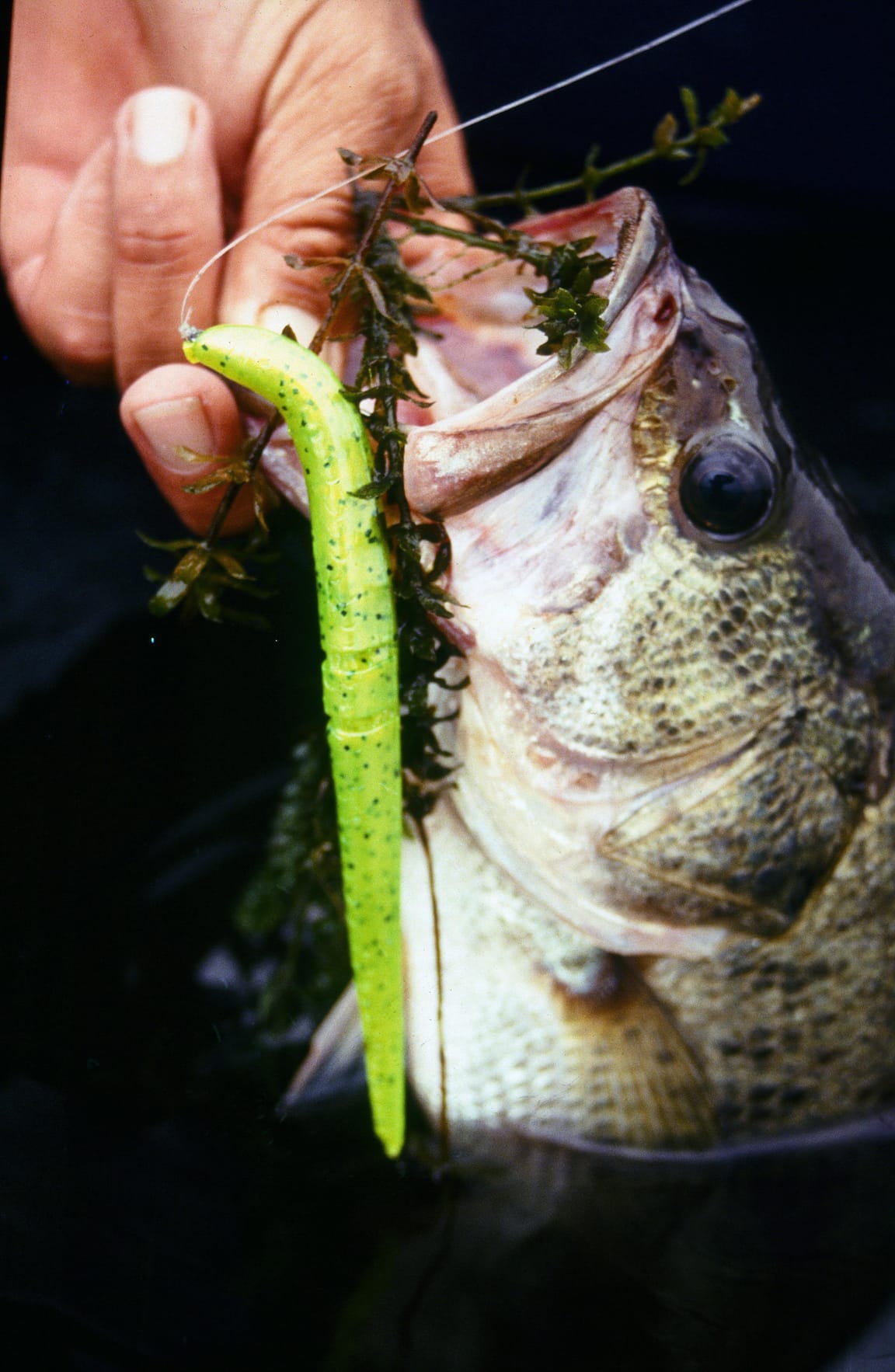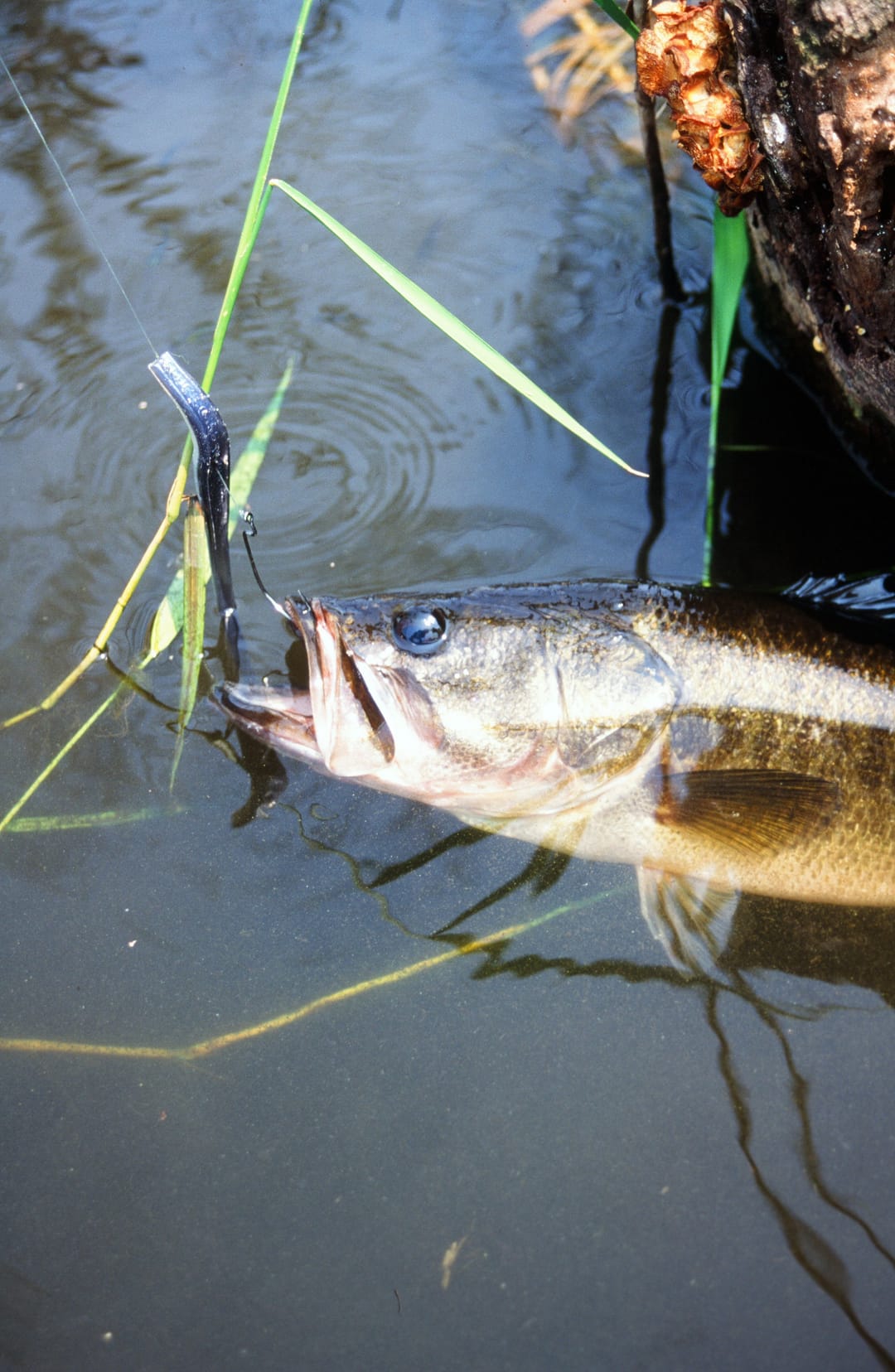by Bob McNally
Thread a plastic worm on a hook below a 5/8-ounce bullet weight, cast it out, and feel for that electric tap-tap on the end of the line.

A plastic worm has likely produced more bass than any two other bass lures combined. Don’t limit your worm fishing to a basic Texas-rig. Worms are versatile.
The Texas-rig, as it’s known, has probably produced more bass bites than any lure and technique in the history of bass fishing. While great, a Texas rig should not be an angler’s sole weapon in his or her worm-fishing arsenal.
The following five techniques for fishing plastic worms are good alternate methods for standard Texas-rig fishing.
Not every tactic works every time on the water, but these methods allow fishermen to greatly increase their options, putting more largemouth, spotted bass and smallmouths in the boat at times when the standard Texas rig fails.
No. 1: The Carolina Option
A Texas-rigged worm works great in heavy cover. An angler can fish it through stumps beds, brushpiles, grassbeds—the thickest, fishiest cover available. For more open-water situations, like a main-lake point, a hump, or gravel flat, there’s a better option that will cover more water more quickly, and that option is the Carolina-rig.
The difference between a Carolina rig and a Texas rig is that with the C-rig the hook and weight are separated by a length of line (3 feet is standard), a swivel, a bead to protect the swivel knot from the weight, and then a 3/4-ounce to 1-ounce round weight.
The weight stirs up silt and creates a commotion when dragged across the bottom, getting a bass’s attention, and then along comes the worm, often floating up above the bottom and slowly sinking as the bass sees it. The Carolina-rigged worm is a great option, often used as a search bait to find schools of bass on main-lake structure.
No. 2: Wind Drifting With Worms
In strong wind, many worm fishermen turn to other lures, like spoons, crankbaits, spinnerbaits or jigs. While those lures and their inherent tactics can be good, more anglers should use the wind as their ally in presenting worms to bass.
To work windy water with worms, motor upwind and use the trolling motor to make a controlled drift over the water you intend to fish.
The trick is to make controlled drifts, with worms cast out behind a boat, using the wind to move you across spots holding feeding bass. Try to hold the boat sideways to the wind, but if the drift is too fast, sometimes turning the boat in-line with the wind may be better. A sea-anchor also can help slow a drift in very strong wind.
No. 3: Hole-Hopping Weeds With Worms
This same technique can be employed using weedless spoons, spinnerbaits, and weedless plastic frogs, but rarely are those lures better at probing holes in weed beds than a plastic worm.

A worm is a great option for fishing weed beds. In very thick vegetation, it’s often the only option.
The technique is simple. Just cast far back into the vegetation, and using rod work, guide the worm to open pockets in weeds. Often bass follow the motion line of a worm crawling across the top-side of weeds. So when the lure hits an opening, the bass is already there, mouth open and waiting. Sometimes bass blow up on worms skittered across weeds. When that happens, glide the lure as quickly as possible to the closest hole, allowing the bass to find and hit the lure.
There are two good options for probing holes in thick vegetation. For longer casts where an angler moves the worm across the weed bed and then lets it fall in the holes, use as light a bullet weight as you can effectively cast. A 1/4-ounce is plenty. Too heavy of a weight won’t allow an angler to move the rig across the surface of the weed beds.
Or, use stealth to move in close to weed bed and drop a Texas-rigged worm into the holes. In thick weed beds without many holes, anglers “punch” the weed beds with heavy 1 1/2-ounce weights that penetrate the surface vegetation. For punching, an angler will need a stout rod and heavy line to get a bass to the boat.
No. 4: Bottom-Hopping Worms
The standard retrieve method for an angler using a sunken plastic worm is a slow crawl that imparts a snake-like slither to the lure across a lake or river floor. That retrieve has been the undoing of plenty of bass. But retrieving a worm in only that manner is akin to fishing a crankbait with only one speed, winter or summer, fall or spring, cold water or warm.
At times, bass want a super-active, high-hopping, pulsating and gyrating plastic worm—just like at times they want a spinnerbait moving fast or irregularly; or a topwater plug zigging and zagging. Try hopping a bottom-contact worm a foot or two, or more, off the bottom if your usual slow-crawl isn’t producing. For summer fishing, high, aggressive hopping is my standard worm retrieve when fishing a Texas rig.
No. 5: Wacky Worming
In clear water for spooky, pressured bass, a wacky rigged worm is one of the most deadly ways to unnerve bass. Another plus for the wacky tactic is not many bass have seen a worm rigged and fished this way.
Wacky-style rigging is pretty simple. With a standard worm hook, simply barb the lure once through its middle. Usually the lure is used with an exposed worm hook, and often no weight. If weight is desired, it can be set up with a split-shot pinched on the fishing line a foot or two above the worm hook. A better way is to insert a nail-type sinker into the worm plastic, head or tail. Usually a thin-diameter worm is used to get the most action from the lure as it falls through the water column. Hooking a worm wacky style also worm at times when using a Carolina rig on main-lake structure. Drag the Carolina rig a little more aggressively than normal to get the wacky-style worm to impart the pulsing action.
A weedless hook can be used, or one can be rigged weedless by threading one end of a rubber band through the hook eye, then securing the other end of the rubber band under the hook barb. Weedless-hook wacky worms are great for fishing deep, clear-water weed edges, docks and standing timber.
A plastic worm is a great bass lure. But don’t limit your worm fishing to Texas rigs fished slowly and with finesse. The worm is a versatile bait.
The Union Sportsmen’s Alliance website is designed to provide valuable articles about hunting, fishing and conservation for members of AFL-CIO affiliated labor unions and all sportsmen and sportswomen who appreciate hunting and fishing and want to preserve our outdoor heritage for future generations. If you would like your own story and experience from the outdoors to be considered for our website, please email us at [email protected].







